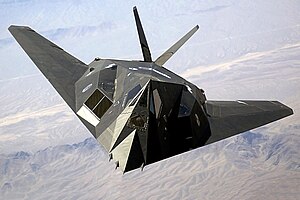F-117A
| F-117 Nighthawk | |
|---|---|
 |
|
| F-117 flying over mountains in Nevada in 2002 | |
| Role | Stealth attack aircraft |
| National origin | United States |
| Manufacturer | Lockheed Corporation |
| First flight | 18 June 1981 |
| Introduction | October 1983 |
| Retired | 22 April 2008 |
| Primary user | United States Air Force |
| Number built | 64 (5 YF-117As, 59 F-117As) |
| Unit cost | |
| Developed from | Lockheed Have Blue |
The Lockheed F-117 Nighthawk is a single-seat, twin-engine stealth attack aircraft that was developed by Lockheed's secretive Skunk Works division and operated by the United States Air Force (USAF). The F-117 was based on the Have Blue technology demonstrator, and was the first operational aircraft to be designed around stealth technology. The maiden flight of the Nighthawk took place in 1981, and the aircraft achieved initial operating capability status in 1983. The Nighthawk was shrouded in secrecy until it was revealed to the public in 1988.
The F-117 was widely publicized for its role in the Persian Gulf War of 1991. Although it was commonly referred to as the "Stealth Fighter", it was strictly an attack aircraft. F-117s took part in the conflict in Yugoslavia, where one was shot down by a surface-to-air missile (SAM) on 27 March 1999; it was the only Nighthawk to be lost in combat. The U.S. Air Force retired the F-117 on 22 April 2008, primarily due to the fielding of the F-22 Raptor. Sixty-four F-117s were built, 59 of which were production versions, with the other five being demonstrators/prototypes.
In 1964, Pyotr Ufimtsev, a Soviet mathematician, published a seminal paper titled Method of Edge Waves in the Physical Theory of Diffraction in the journal of the Moscow Institute for Radio Engineering, in which he showed that the strength of the radar return from an object is related to its edge configuration, not its size. Ufimtsev was extending theoretical work published by the German physicist Arnold Sommerfeld. Ufimtsev demonstrated that he could calculate the radar cross-section across a wing's surface and along its edge. The obvious and logical conclusion was that even a large aircraft could be made difficult to see by radar by exploiting this principle. However, the airplane's design would make it aerodynamically unstable, and the state of computer technology in the early 1960s could not provide the kinds of flight computers which would later allow aircraft such as the F-117 and B-2 Spirit to stay airborne. By the 1970s, when Lockheed analyst Denys Overholser found Ufimtsev's paper, computers and software had advanced significantly, and the stage was set for the development of a stealthy airplane.
...
Wikipedia
